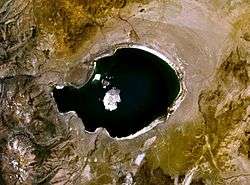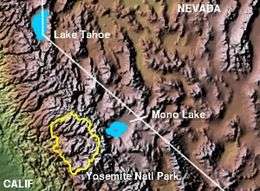Mono Lake
Mono Lake (/ˈmoʊnoʊ/ MOH-noh) is a large, shallow saline soda lake in Mono County, California, formed at least 760,000 years ago as a terminal lake in an endorheic basin. The lack of an outlet causes high levels of salts to accumulate in the lake. These salts also make the lake water alkaline.
This desert lake has an unusually productive ecosystem based on brine shrimp that thrive in its waters, and provides critical nesting habitat for two million annual migratory birds that feed on the shrimp and blackflies (that also feed on the shrimp).[2][3]
The human history of Mono Lake is associated with its productive ecosystem. The native Kutzadika'a people derived nutrition from the pupae of the alkali flies that live in the lake. When the city of Los Angeles diverted water from the lake, it lowered the lake level, which imperiled the migratory birds. The Mono Lake Committee formed in response and won a legal battle that forced Los Angeles to partially restore the lake level.
Geology
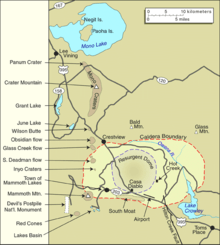
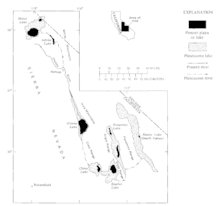
Mono Lake occupies part of the Mono Basin, an endorheic basin that has no outlet to the ocean. Dissolved salts in the runoff thus remain in the lake and raise the water's pH levels and salt concentration. The tributaries of Mono Lake include Lee Vining Creek, Rush Creek and Mill Creek which flows through Lundy Canyon.[4]
The basin was formed by geological forces over the last five million years: basin and range crustal stretching and associated volcanism and faulting at the base of the Sierra Nevada.[5] Five million years ago, the Sierra Nevada was an eroded set of rolling hills and Mono Basin and Owens Valley did not yet exist.
From 4.5 to 2.6 million years ago, large volumes of basalt were extruded around what is now Cowtrack Mountain (east and south of Mono Basin); eventually covering 300 square miles (780 km2) and reaching a maximum thickness of 600 feet (180 m).[5] Later volcanism in the area occurred 3.8 million to 250,000 years ago.[6] This activity was northwest of Mono Basin and included the formation of Aurora Crater, Beauty Peak, Cedar Hill (later an island in the highest stands of Mono Lake), and Mount Hicks.
Mono Lake is believed to have formed at least 760,000 years ago, dating back to the Long Valley eruption. Sediments located below the ash layer hint that Mono Lake could be a remnant of a larger and older lake that once covered a large part of Nevada and Utah, which would put it among the oldest lakes in North America. At its height during the most recent ice age, the lake would have been about 900 feet (270 m) deep.[7] Prominent old shore lines, called strandlines by geologists, can be seen west of the Lake.[8]
Currently, Mono Lake is in a geologically active area at the north end of the Mono–Inyo Craters volcanic chain and is close to Long Valley Caldera. Volcanic activity continues in the Mono Lake vicinity: the most recent eruption occurred 350 years ago, resulting in the formation of Paoha Island. Panum Crater (on the south shore of the lake) is an excellent example of a combined rhyolite dome and cinder cone.
Limnology
The limnology of the lake shows it contains approximately 280 million tons of dissolved salts, with the salinity varying depending upon the amount of water in the lake at any given time. Before 1941, average salinity was approximately 50 grams per liter (g/l) (compared to a value of 31.5 g/l for the world's oceans). In January 1982, when the lake reached its lowest level of 6,372 feet (1,942 m), the salinity had nearly doubled to 99 g/l. In 2002, it was measured at 78 g/l and is expected to stabilize at an average 69 g/l as the lake replenishes over the next 20 years.[9]
An unintended consequence of ending the water diversions was the onset of a period of "meromixis" in Mono Lake.[10] In the time prior to this, Mono Lake was typically "monomictic"; which means that at least once each year the deeper waters and the shallower waters of the lake mixed thoroughly, thus bringing oxygen and other nutrients to the deep waters. In meromictic lakes, the deeper waters do not undergo this mixing; the deeper layers are more saline than the water near the surface, and are typically nearly devoid of oxygen. As a result, becoming meromictic greatly changes a lake's ecology.
Mono Lake has experienced meromictic periods in the past; this most recent episode of meromixis, brought on by the end of the water diversions, commenced in 1994 and had ended by 2004.[11]
Ecology
Aquatic life


The hypersalinity and high alkalinity (pH=10 or equivalent to 4 milligrams of NaOH per liter of water) of the lake means that no fish are native to the lake.[12] An attempt by the California Department of Fish and Game to stock the lake failed.
The whole food chain of the lake is based on the high population of single-celled planktonic algae present in the photic zone of the lake. These algae reproduce rapidly during winter and early spring after winter runoff brings nutrients to the surface layer of water. By March the lake is "as green as pea soup" with photosynthesizing algae.[13]
The lake is famous for the Mono Lake brine shrimp, Artemia monica, a tiny species of brine shrimp, no bigger than a thumbnail, that are endemic to the lake. During the warmer summer months, an estimated 4–6 trillion brine shrimp inhabit the lake. Brine shrimp have no food value for humans, but are a staple for birds of the region. The brine shrimp feed on microscopic algae.
Alkali flies, Ephydra hians live along the shores of the lake and walk underwater, encased in small air bubbles for grazing and to lay eggs. These flies are an important source of food for migratory and nesting birds.
Birds
Mono Lake is a vital resting and eating stop for migratory shorebirds and has been recognized as a site of international importance by the Western Hemisphere Shorebird Reserve Network.[14] Nearly 2,000,000 waterbirds, including 35 species of shorebirds, use Mono Lake to rest and eat for at least part of the year. Some shorebirds that depend on the resources of Mono Lake include American avocets, killdeer and sandpipers. Over 1.5 million eared grebes and phalaropes use Mono Lake during their long migrations.
Late every summer tens of thousands of Wilson's phalaropes and red-necked phalaropes arrive from their nesting grounds, and feed until they continue their migration to South America or the tropical oceans respectively.[2]
In addition to migratory birds, a few species spend several months to nest at Mono Lake. Mono Lake has the second largest nesting population of California gulls, Larus californicus, second only to the Great Salt Lake in Utah. Since abandoning the landbridged Negit Island in the late 1970s, California gulls have moved to some nearby islets and have established new, if less protected, nesting sites. Cornell University and Point Reyes Bird Observatory have continued the study of nesting populations on Mono Lake that was begun over 20 years ago. Snowy plovers also arrive at Mono Lake each spring to nest along the remote eastern shores.
History

Native Americans
The indigenous people of Mono Lake are from a band of the Northern Paiute, called the Kutzadika'a.[15] They speak the Northern Paiute language.[16] The Kutzadika'a traditionally forage alkali fly pupae, called kutsavi in their language.[17] Mono Lake was also referred to as Teniega Bah. The origin of the name "Kutzadika'a" is uncertain but could be a Yokut Native American term for "fly eater".
The term "Mono" is derived from "Monachi", a Yokut term for the tribes that live on both the east and west side of the Sierra Nevada.[18]
During early contact the first known Mono Lake Paiute chief was Captain John. He was also referred to by the Paiute names of Shibana or Poko Tucket. Captain John was the son of a Northern Paiute named 'older Captain John.'
The Mono tribe has two bands: Eastern and Western. The Eastern Mono joined the Western Mono bands' villages annually at Hetch Hetchy Valley, Yosemite Valley, and along the Merced River to gather acorns, different plant species, and to trade. The Western Mono traditionally lived in the south-central Sierra Nevada foothills, including Historical Yosemite Valley.[19]
Present day Mono Reservations are currently located in Big Pine, Bishop, and several in Madera County and Fresno County, California.
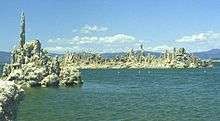

Conservation efforts
The city of Los Angeles diverted water from the Owens River into the Los Angeles Aqueduct in 1913. In 1941, the Los Angeles Department of Water and Power extended the Los Angeles Aqueduct system farther upriver into the Mono Basin. So much water was diverted that evaporation soon exceeded inflow and the surface level of Mono Lake fell rapidly. By 1982 the lake was reduced to 37,688 acres (15,252 ha) 69 percent of its 1941 surface area. "[By 1990, the lake had dropped 45 vertical feet and had lost half its volume]" relative to the 1941 pre-diversion water level.[20] As a result, alkaline sands and formerly submerged tufa towers became exposed, the water salinity doubled, and Negit Island became a peninsula, exposing the nests of california gulls to predators (such as coyotes), and forcing the sea gull colony to abandon this site.
In 1974, Stanford University graduate student David Gaines studied the Mono Lake ecosystem, and he became instrumental in alerting the public of the effects of the lower water level.[21] The National Science Foundation funded the first comprehensive ecological study of Mono Lake, conducted by Gaines and undergraduate students from the University of California at Davis, the University of California at Santa Cruz, and Earlham College. In June 1977, the Davis Institute of Ecology of the University of California published a report, "An Ecological Study of Mono Lake, California," which alerted California to the ecological dangers posed by the redirection of water away from the lake for municipal uses.[21]
.jpg)
Gaines formed the Mono Lake Committee in 1978. He and Sally Judy, a UC Davis student, led the committee and pursued an informational tour of California. They joined with the Audubon Society to fight a now famous court battle, the National Audubon Society v. Superior Court, to protect Mono Lake through state public trust laws.[21] While these efforts have resulted in positive change, the surface level is still below historical levels, and exposed shorelines are a source of significant alkaline dust during periods of high winds.
Owens Lake, the once-navigable terminus of the Owens River which had sustained a healthy ecosystem, is now a dry lake bed during dry years due to water diversion beginning in the 1920s. Mono Lake was spared this fate when the California State Water Resources Control Board (after over a decade of litigation) issued an order to protect Mono Lake and its tributary streams on September 28, 1994. Since that time, the lake level has steadily risen. In 1941 the surface level was at 6,417 feet (1,956 m) above sea level.[22] As of October 2013, Mono Lake was at 6,380.6 feet (1,945 m) above sea level.[22] The lake level of 6,392 feet (1,948 m) above sea level is the goal, a goal made more difficult during years of drought in the American West.
In popular culture
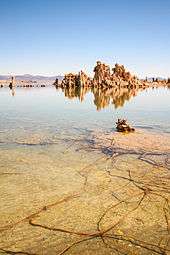
Artwork
- The Diver, a photo taken by Storm Thorgerson for Pink Floyd's album Wish You Were Here (1975), features what appears to be a man diving into a lake, creating no ripples. The photo was taken at Mono Lake, and the tufa towers are a prominent part of the landscape. The effect was actually created when the diver performed a handstand underwater until the ripples dissipated.[23]
Film
- The volcano scene from the film Fair Wind to Java (1953)[24] was shot at Mono Lake. Today, the remnants of the volcano host California gull researchers on their visits to the island.[25]
- The Clint Eastwood film High Plains Drifter was shot on location at Mono Lake in 1972, and the lake features prominently.
- In the TV show Weeds, Peter Scottson mentions Mono Lake as his favorite body of water. Season 1 episode 8.
Music
- The music video for glam metal band Cinderella's 1988 power ballad Don't Know What You Got ('Till It's Gone) was filmed by the lake.[26]
- The electronic music artist named Monolake got his name from the lake.
In print
- Mark Twain's Roughing It, published in 1872, provides a humorous and informative early description of Mono Lake in its natural condition in the 1860s[27][28] Twain found the lake to be a "lifeless, treeless, hideous desert... the loneliest place on earth."[7]
- Chapter 1 of James Rollins' tenth Sigma Force novel, The 6th Extinction (2014), opens with a tour and talks about the lake by a nature guide and Park Ranger. The lake's characteristics play an integral role throughout the book, whose fictional story draws heavily from science.
See also
- List of lakes in California
- Mono Lake Tufa State Reserve
- Mono Basin National Scenic Area
- GFAJ-1, an organism from Mono Lake that has been at the center of a scientific controversy over hypothetical arsenic in DNA.
- List of drying lakes
Notes
- 1 2 3 "Quick Facts About Mono Lake". Mono Lake Committee.
- 1 2 "Birds of the Basin: the Migratory Millions of Mono". Mono Lake Committee. Retrieved 2010-12-02.
- ↑ Carle, David (2004). Introduction to Water in California. Berkeley: University of California Press. ISBN 0-520-24086-3.
- ↑ U.S. Geological Survey Geographic Names Information System: Lundy Canyon
- 1 2 Tierney 2000, p. 45
- ↑ Tierney 2000, p. 46
- 1 2 Harris 2005, p. 61
- ↑ "Mono Lake". Long Valley Caldera Field Guide. USGS.
- ↑ "Mono Lake FAQ". Mono Lake Committee. Retrieved 2010-12-02.
- ↑ Jellison, R.; J. Romero; J. M. Melack (1998). "The onset of meromixis in Mono Lake: unintended consequences of reducing water diversions" (PDF). Limnology and Oceanograph. 3 (4): 704–11. Retrieved 2008-11-13.
- ↑ Jellison, R.; S. Roll (2003). "Weakening and near-breakdown of meromixis in Mono Lake" (PDF). unpublished; online version. Retrieved 2008-11-13.
- ↑ "Living in an Alkaline Environment". Microbial Life Education Resources. Retrieved 2008-11-12.
- ↑ "Mono Lake". Ecoscenario. Retrieved 2007-01-23.
- ↑ "Mono Lake". Western Hemisphere Shorebird Reserve Network. Retrieved 2011-05-09.
- ↑ "Kutzadika'a People: Living in Harmony with the Mono Basin". Mono Lake Committee. Retrieved 31 August 2010.
- ↑ "California Indians and Their Reservations: K". SDSU Library and Information Access. Archived from the original on 2010-09-26. Retrieved 31 August 2010.
- ↑ "American Indians Ate Insects". Manataka™ American Indian Council.
- ↑ Farquhar, Francis (1926). Place Names of the High Sierra. San Francisco: Sierra Club.
- ↑ "California Indians and Their Reservations". SDSU Library and Information Access. Archived from the original on 2010-07-26. Retrieved 24 July 2009.
- ↑ "About Mono Lake". Mono Lake Committee. Retrieved 2004. Check date values in:
|access-date=(help) - 1 2 3 "History of the Mono Lake Committee". Mono Lake Committee. Retrieved 2010-12-02.
- 1 2 "Monthly Lake Levels". Mono Basin Research Clearinghouse. Retrieved 2004. Check date values in:
|access-date=(help) - ↑ "Floyd Extra! How Wish You Were Here Went Up In Flames". MOJO magazine. September 2011.
- ↑ Fair Wind to Java, IMDB
- ↑ Banding California Gulls at Mono Lake, Mary Malec, 20 July 2009. Retrieved 6 March 2010.
- ↑ Sweeney, Mike (July 19, 2011). "Don't Know What You Got ('Till It's Gone)". The Huffington Post. Retrieved January 12, 2014.
- ↑ Twain, Mark. "chapter 38". Roughing It. University of Virginia Library: Electronic Text Center. ISBN 0-19-515979-9. Retrieved 2008-11-12.
- ↑ Twain, Mark. "chapter 39". Roughing It. University of Virginia Library: Electronic Text Center. ISBN 0-19-515979-9. Retrieved 2008-11-12.
References
- Harris, S.L. (2005). Fire Mountains of the West: The Cascade and Mono Lake Volcanoes. Mountain Press. ISBN 978-0-87842-511-2.
- Jayko, A.S., et al. (2013). Methods and Spatial Extent of Geophysical Investigations, Mono Lake, California, 2009 to 2011. Reston, Va.: U.S. Department of the Interior, U.S. Geological Survey.
- Miller, C.D.; et al. (1982). "Potential hazards from future volcanic eruptions in the Long Valley-Mono Lake area, east-central California and southwest Nevada : a preliminary assessment". U.S. Geological Survey Circular 877. Reston, Virginia: U.S. Geological Survey.
- Tierney, Timothy (2000). Geology of the Mono Basin (revised ed.). Lee Vining, California: Kutsavi Press, Mono Lake Committee. ISBN 0-939716-08-9.
External links
| Wikivoyage has a travel guide for Mono Lake. |
| Wikimedia Commons has media related to Mono Lake. |
- Mono Lake Area Visitor Information
- Mono Lake Tufa State Nature Reserve
- Mono Lake Committee website
- Mono Lake Visitor Guide
- "World Lake Database entry for Mono Lake". Retrieved 2010-12-02.
- Landsat image of Mono Lake
- Roadside Geology and Mining History of the Owens Valley and Mono Basin
